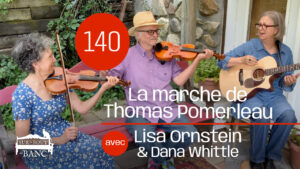
No 140 – La marche de Thomas Pomerleau – avec Lisa Ornstein & Dana Whittle
Avec Lisa Ornstein et Dana Whittle. Un plaisir de jouer avec Lisa, qui a tant exploré et mis en valeur le répertoire ancien et méconnu du violon traditionnel Québécois. Ces airs nous sont souvent parvenus grâce au jeu soulevant de Henry Landry. Je suis un homme comblé avec ces deux femmes folk de la première heure. 🎻 With Lisa Ornstein and Dana Whittle. It is always a pleasure to play with Lisa, who has explored and shone a light on some of the ancient and little-known repertoire of Québec’s traditional fiddle tunes. Some of these melodies have reached us thanks to the dynamic playing of Victoriaville fiddler Henry Landry. I couldn’t be happier than when I have a chance to share the bench with these two “femmes folk”!

No 139 – La gigue de Sherbrooke – avec Marc Benoît
Avec Marc Benoît. Un air du répertoire de Jean Carignan, l’illustre violoneux québécois. Dés son jeune âge il a appris une quantité de pièces de son père pour ensuite découvrir les airs des fameux musiciens d’Irlande et d’Écosse. 🎻 With Marc Benoît. A tune from the repertoire illustrious Québécois fiddler Jean Carignan. Starting as a child, he learned many tunes from his father and then went on to discover many more from famous Irish and Scottish musicians.
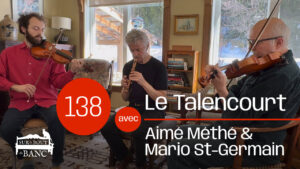
No 138 – Le Talencourt – avec Aimé Méthé & Mario St-Germain
Avec Aimé Méthé et Mario St-Germain. Cet air semble être une composition ancienne québécoise. Elle a été jouée beaucoup au violon et à l’harmonica dans la région du Lac Saint-Jean. J’imagine bien cette pièce jouée à la cour du roi de France. À l’époque, j’en jouais souvent lorsque j’étais membre du groupe Manigance. 🎻 With Aimé Méthé and Mario St-Germain. This tune seems to be an old Quebec composition. It was played a lot on violin and harmonica in the Lac Saint-Jean region of Québec. my ear, it has the kind of character that might have been heard in the court music played for the King of France. Back in the day, I often played it when I was a member of the group Manigance.
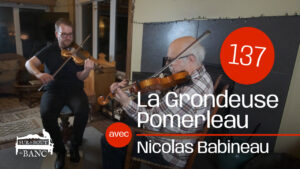
No 137 – La Grondeuse Pomerleau – avec Nicolas Babineau
Avec Nicolas Babineau. Monsieur Thomas Pomerleau fut un violoneux itinérant qui vivait bien humblement en Estrie. Nous avons découvert sa musique sur un album du violoneux Henri Landry (sur étiquette Philo Records, Vermont) qui lui rendait un bel hommage dans son jeu soulevant aux couleurs de la tradition. On raconte que Thomas, pour obtenir l’absolution du curé après la confession, devait mettre son violon dans le poêle dès le retour à sa maison. Ce qu’il fit aussitôt… en s’assurant que le feu était bien éteint! 🎻 With Nicolas Babineau. Monsieur Thomas Pomerleau was an itinerant fiddler who lived a simple life in the Estrie region of Québec. We discovered his music on an album by fiddler Henri Landry (on Vermont label Philo Records) who paid him eloquent tribute with his playing infused with the colors of tradition. It is said that Thomas, to obtain absolution from the priest after confession, was told to put his violin into the stove as soon as he returned home. He did so immediately… after making sure the fire was extinguished!
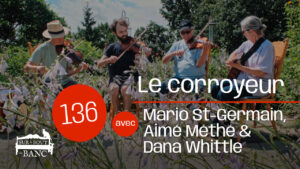
No 136 – Le corroyeur – avec Mario St-Germain, Aimé Méthé & Dana Whittle
Avec Aimé Méthé, Mario St-Germain et Dana Whittle. text. Quelle belle surprise de voir Aimé arriver avec sa première composition trad dans la continuation des pièces de gigue simple québécoise. Le corroyeur, outil élémentaire dans le travail du bois, sert à dégauchir les pièces. L’air se retrouve sur notre album familial « Mon père a fait bâtir maison ». 🎻 With Aimé Méthé, Mario St-Germain and Dana Whittle. text. What a nice surprise to see Aimé arrive with his first trad composition in the continuation of the simple Québécois jig pieces. The jointer, an essential woodworking tool, is used to plane a wood surface so that the edges of boards will meet up evenly. This tune can be found on our family album “Mon père a fait bâtir maison” (My father built a house).

No 135 – Reel de Lévis – avec Yvon Mimeault
Avec Yvon Mimeault. Nous étions charmés de rejoindre Yvon chez lui à Amqui (au printemps 2022) et retrouver le personnage jovial et volubile, ce violoneux gaucher nonagénaire (on le trouve pas mal “non” agénaire), toujours très adroit sur son instrument, un vrai maître de tradition. Ici, nous partageons une pièce de Jean Carignan, une des milliers jouées par le célèbre violoneux né à Lévis. 🎻 With Yvon Mimeault. We were delighted to visit with Yvon at his home in Amqui in spring of 2022. A perpetually jovial and animated character, this left-handed fiddler, even in his nineties, is supremely skilled on his instrument and seemingly ageless master of tradition. Here, he shares a piece from Jean Carignan, one of thousands played by the famous fiddler who was born in Lévis, Québec.
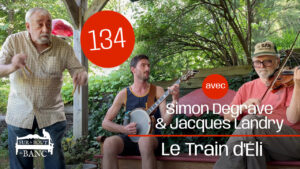
No 134 – Le Train d’Éli – avec Simon Degrave & Jacques Landry
Avec Simon Degrave et Jacques Landry. Cette fois, c’est une composition de notre ami Simon! – “J’ai composé cette pièce en automne 2018. Installé dans une petite maison du quartier de Lille-Fives, mes colocataires étaient un petit garçon du nom d’Éli et son père Isaac. Une semaine sur deux quand Eli revenait de chez sa mère, il apportait avec lui, non pas sa doudou, non pas de toutou, mais son train en bois! Et la première chose qu’il faisait en arrivant, c’etait, avec son père, de reconstruire le chemin de fer de bois pour son train au milieu du salon.” 🎻 With Simon Degrave and Jacques Landry. This time, it’s a composition from our friend Simon! – “I composed this piece in the fall of 2018. Living in a small house in the Lille-Fives district, my roommates were a little boy named Eli and his father Isaac. Every other week when Eli came back from his mother’s house, he brought with him, not his blanket, not a stuffed animal, but his wooden train! And the first thing he did when he arrived was, with the help of his father, rebuild the wooden railway for his train in the middle of the living room.”
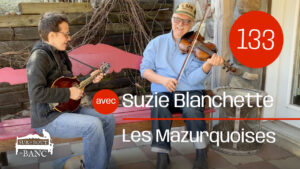
No 133 – Les Mazurquoises – avec Suzie Blanchette
Avec Suzie Blanchette. Les valses et mazurkas quoique toutes les deux soient à trois temps sont deux danses de couple qui semblent avoir un tempo désiré qui diffère selon les cultures. Ici elle sautille plus qu’une valse. La première apparaît comme «La Cantinette» sur notre album de famille (mais en Bb au lieu de D) du 2023, «Mon père a fait bâtir maison». J’appelle la deuxième «Béonette» pour notre fille Béatrix, l’instigatrice de cet album, et de la musique qui a fait partie de notre maison. 🎻 With Suzie Blanchette. Waltzes and mazurkas, although both in three beats, are two partner dances that seem to have a tempo that differs between cultures. Here they “skip” a bit more than a waltz. The first is “La Cantinette”, and appears (but in Bb instead of D) on our 2023 family album, “Mon père a fait bâtir maison”. I call the second “Béonette” for Béatrix, the instigator of the aforementioned album and of much of the music that was always happening in our house.

No 132 – Les Fous de Bassan – avec Louis-Philippe Morel
Avec Louis-Philippe Morel. Tourné par un jour très venteux de l’été 2022, il s’agit d’une reprise (Bout du banc No 63) aux violons sans accompagnement d’une composition inspirée de ces oiseaux plongeurs des falaises. J’ai eu la chance de les voir faire leurs acrobaties lors d’une visite à Percé, Québec. 🎻 With Louis-Philippe Morel. Filmed on a very windy day during the summer of 2022, this is a fiddles-only reprise (Bout du banc No 63) of a composition that was inspired by these cliff-diving birds. I had the good fortune to watch them do their acrobatics on a visit to Percé, Québec in the Gaspé region.
